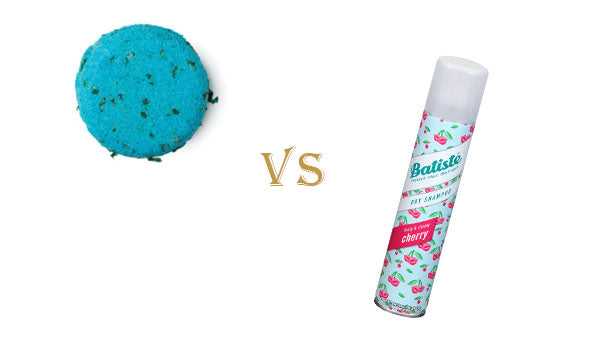
Many of us are thinking more about the products we buy and how it impacts the environment. How much plastic is it packaged in? How much gas (petrol) does it take to ship it to our shops or door? Another concern that around how much water it takes to produce or use the product.
Saying all that, we still want a product that works. And this is especially true of shampoo. There is nothing so annoying, nothing that makes you feel as grubby as a head full of greasy hair.
The two options for tackling dirty hair with an environmentally sensitive solution are shampoo bars and dry powders. We wanted to try and objectively compare both to answer the questions; which is better for your hair and which is better for the environment.
Bar Shampoo or Dry Shampoo - which is better for your hair?
Now, you may say this isn’t comparing apples with apples. A shampoo bar is designed to replace your regular liquid shampoo, while a dry shampoo is meant to be used in-between shampoos. However, lets just look at the pros and cons for each of them.
Dry Shampoos efficacy pros and cons
Dry shampoos won’t really get your hair clean. They are designed with ingredients that soak up oil and maybe add a dash of silicone for slip and fragrance the hair. Many of the leading brands that come in aerosol cans usually include alcohol and propellants like butane and propane which can be drying to the scalp.
However, one of the pros of dry shampoos are, because they don’t use water, they are actually kinder to your hair. Water is quite damaging to the hair, it makes it swell and dry out. Water also temporarily breaks hydrogen bonds in the hair making it weaker and more prone to snap or split.
Shampoo bars efficacy pros and cons
Shampoo bars can be formulated with all of the good things that liquid shampoos can contain. Things like pro-vitamin B5 and nourishing oils. They get the hair as clean as liquid shampoos - which can be too clean.
Like liquid shampoos you will need to rinse the hair with water, which will damage the hair to some extent. Because the bars can be quite hard and do not lather much, you may find yourself rubbing quite hard on your hair - which will cause damage.
Dry shampoo environmental impact
The premise of dry shampoo is very environmentally sustainable. It reduces our reliance on water and the base ingredients are usually quite benign (clays and starch). However, most dry shampoos come in aerosol form in either plastic or steel containers. We’re guessing half the weight of these products is propellent, alcohol or can - not product. It’s fair to say that using prollents to spray dry shampoo in the vague direction of your roots is a bit wasteful. There is only one dry shampoo on Amazon that doesn’t come in a spray can.
Shampoo bars environmental impact
Most shampoo bars are either lightly wrapped in a highly recyclable packaging or come naked. They don’t contain any ingredients that are not there to clean or nourish the hair and a bar can last for months. This means that nothing superfluous (like the water of liquid shampoo) consumes weight (and petrol) while shipping.
The surfactants used in these bars are usually biodegradable but many consume water in their manufacture and you obviously do need to use water the use the bar.
Conclusion
Shampoo bars do seem to be the most efficient and ecologically sound way to wash your hair. However we think there is a place for a dry shampoo to stretch out the time between these washes. Washing hair with water is known to be damaging and there may come a time when water is in short supply. A combination of both forms is the winning formula.
